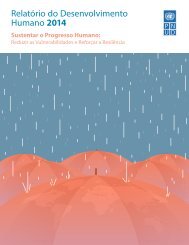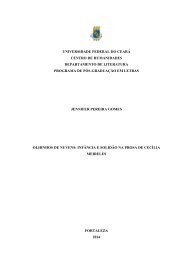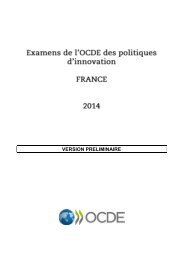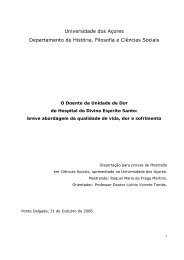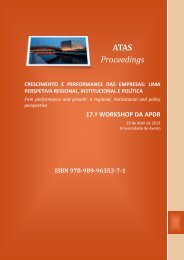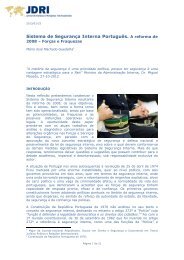1POTXAdSn
1POTXAdSn
1POTXAdSn
You also want an ePaper? Increase the reach of your titles
YUMPU automatically turns print PDFs into web optimized ePapers that Google loves.
Fruto do isolamento, da situação geográfica e das<br />
peculiaridades dos seus habitats, os arquipélagos<br />
macaronésicos desenvolveram muitas espécies e comunidades<br />
únicas no mundo, sendo actualmente reconhecidos<br />
como o centro mais importante da região<br />
bioclimática mediterrânico, um dos 25 hotspots de<br />
biodiversidade a nível mundial (Myers et al. 2000).<br />
Para a extraordinária biodiversidade da Macaronésia<br />
em muito contribuem os moluscos terrestres, uma vez<br />
que das 30 000 a 50 000 espécies que se conhecem a<br />
nível mundial, cerca de 10 000 habitam ilhas e grupos<br />
de ilhas (Gittenberger 2007) e destas, 500 são endemismos<br />
dos Açores, da Madeira e das Canárias, facto<br />
que torna a malacofauna terrestre desta região uma das<br />
mais diversas do mundo (Bank et al. 2002).<br />
O padrão de distribuição dos moluscos terrestres<br />
nas ilhas macaronésicas do Atântico Norte é consistente,<br />
com pequenas variações entre os arquipélagos,<br />
atribuídas aos gradientes climáticos e à distância às<br />
massas continentais, admitindo-se que o arquipélago<br />
da Madeira ocupa uma posição central na distribuição<br />
de espécies (Waldén 1983). Na caracterização da malacofauna<br />
terrestre da Macaronésia, considera-se que<br />
a componente endémica forma uma relíquia colecção,<br />
com afinidade pronunciada à fauna do terciário antigo,<br />
na Zona Paleárctica Ocidental e Mediterrânica, e que<br />
a introduzida reflecte a origem humana do povoamento<br />
(Waldén 1963, 1984). Nestes arquipélagos, alguns<br />
taxa endémicos como Leptaxis e o complexo Napaeus<br />
apresentam disjunções interessantes, com o primeiro<br />
ausente das Canárias e o segundo presente neste arquipélago<br />
e nos Açores mas não na Madeira (Wálden<br />
1984; Martins 1989), situação que também se verifica<br />
com os Zonitidae (=Oxychilidae).<br />
Nos Açores, o arquipélago mais setentrional da<br />
Macaronésia, a origem dos moluscos terrestres é Pa<br />
leárctica, embora a disjunção de alguns taxa (Enidae)<br />
e a peculiaridade de outros (Plutonia), suscitem questões<br />
zoogeográficas estimulantes, também presentes na<br />
radiação e diversidade actual dos Drouetia (Pulmonata,<br />
Zonitidae), quer no arquipélago, quer em cada ilha.<br />
As nove ilhas que compõem o arquipélago dos<br />
Açores possuem 114 espécies de moluscos terrestres,<br />
44% dos quais são endémicos (Cunha et al. 2005). A<br />
riqueza específica da malacofauna dos Açores é inferior<br />
à verificada na Madeira e Selvagens, com 249 es-<br />
170<br />
Owing to their isolation, geographical location and<br />
habitat peculiarities, the Macaronesian archipelagos<br />
have developed many species and communities unique<br />
in the world, and are known today as the most important<br />
centre of the Mediterranean bioclimatic region, one of<br />
the 25 biodiversity hotspots worldwide (Myers et al.<br />
2000). The terrestrial molluscs contribute much to this<br />
extraordinary biodiversity of Macaronesia, since of<br />
the 30 to 50 thousand species known worldwide about<br />
10 thousand inhabit islands and groups of islands<br />
(Gittenberger 2007) and of those, 500 are endemic to<br />
the Azores, Madeira and Canary Islands, what renders<br />
the terrestrial malacofauna of this region “one of the<br />
most diverse of the world (Bank et al. 2002).<br />
The distribution pattern of the terrestrial molluscs<br />
in the Macaronesian islands of the North Atlantic<br />
is consistent, with small variations between the<br />
archipelagos, attributed to the climatic gradients and<br />
distance to continental masses, being reckoned that<br />
the Madeiran archipelago occupies a central position<br />
for the distribution of the species (Waldén 1983). In<br />
the characterization of the terrestrial malacofauna of<br />
the Macaronesia, it is understood that the endemic<br />
component is a relict collection, with pronounced<br />
affinity to the fauna of the Lower Terciary, in the<br />
Occidental and Mediterranean Palaearctic Zone, and<br />
that the introduced fauna reports to the human origin<br />
of the settlements (Waldén 1963, 1984). In these<br />
archipelagos, some endemic taxa such as Leptaxis and<br />
the Napaeus-complex show interesting disjunctions,<br />
with the former absent from the Canary Islands and<br />
the latter present on this archipelago and on the Azores<br />
but not on Madeira (Wálden 1984; Martins 1989), a<br />
situation also true for the Zonitidae (=Oxychilidae).<br />
In the Azores, the northernmost archipelago of the<br />
Macaronesia, the origin of the molluscs is Palaearctic,<br />
although the disjunction of some taxa (Enidae) and<br />
the peculiarity of others (Plutonia) raise stimulating<br />
zoogeographic questions, also present in the present<br />
radiation and diversity of Drouetia (Pulmonata,<br />
Zonitidae), not only on the archipelago but also within<br />
each island.<br />
The nine islands that make the Azores Archipelago<br />
have 114 species of terrestrial molluscs, of which 44%<br />
are endemic (Cunha et al. 2005). The specific richness<br />
of the Azores is inferior to that observed on Madeira and





